Testing the Samsung Galaxy S10 - when will smartphones catch up with the cameras?
Hi, Habr.
Like probably almost all amateur photographers, I'm with some skepticism about taking pictures on mobile phones. Everyone knows about the small matrix, simple optics, and so on. On the other hand, it must be admitted that the possibilities of mobile photography are improving, the matrix becomes less noisy, optical stabilization appears in smartphones, and so on. And finally, when Samsung announced a new smartphone with three cameras (wide-angle, normal and tele), I still could not resist and decided that it was time to take.

Nokia 9 PureView - smartphones are no longer limited to three cameras
')
How it works, and what opportunities the modern smartphone gives the amateur photographer, details under the cut. Caution traffic.
For a start, let's see what is available to the user in terms of "hardware" (all further will relate to the Galaxy S10).
Main camera : 12Mpx, F1.5 / 2.4 switchable aperture, 77˚ viewing angle, optical stabilization (OIS), super-fast (as stated in the advertisement :) autofocus, pixel size 1.4μm.
Telephoto camera : 12Mpx, aperture F2.4, fast phase autofocus (PDAF), OIS, viewing angle 45˚, pixel size 1.0μm.
Wide-angle camera : 16MPx, aperture F2.2, viewing angle 123˚, pixel size 1.0μm.
(in the comments there was a question about EGF of lenses - they are not given in the specification)
Overall, quite good. Not ideal of course, but it is clear that a full-fledged diaphragm, for example, is difficult to shove into the thickness of a smartphone.
Now let's see what opportunities the software gives us.
The camera application built into the smartphone, surprisingly, has quite a few settings. Preset scenes like “Food”, “Cats”, “Dogs” (yes, there are 2 different modes , although I don’t know how they differ) are not so interesting, let's see the so-called “pro” mode:
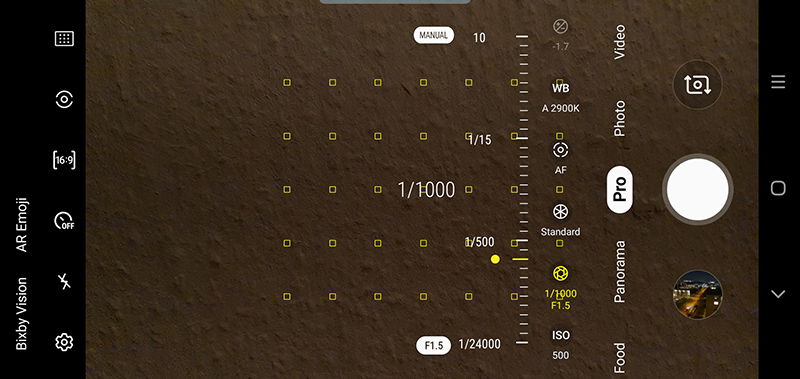
Here you can configure the following parameters:
ISO - 50-800.
Shutter speed - 1/24000 - 10s, switching aperture F1.5 / 2.4.
White balance - auto or manual.
Focus - auto or manual (in manual mode, sharp areas are highlighted with a green frame)
Recording format: JPEG or JPEG + RAW.
Everything looks quite good, and quite at the level of advanced digital cameras. Unfortunately, there is a fly in the ointment - the pro-mode is available only for the “main” camera. Either this hardware limitation (maybe, only the “main” matrix supports ISO change), or the software is just unfinished, it's hard to say.
By the way, anyone can download the alternative Open Camera program from Google Play, which also provides quite a few settings:

So, let's proceed to the tests. For the first test, we will choose a typical “tourist” scenario - shooting of sights on a sunny day.
For those who want to see for themselves, full-size photos are available as an archive as a whole .
Wide-angle lens:
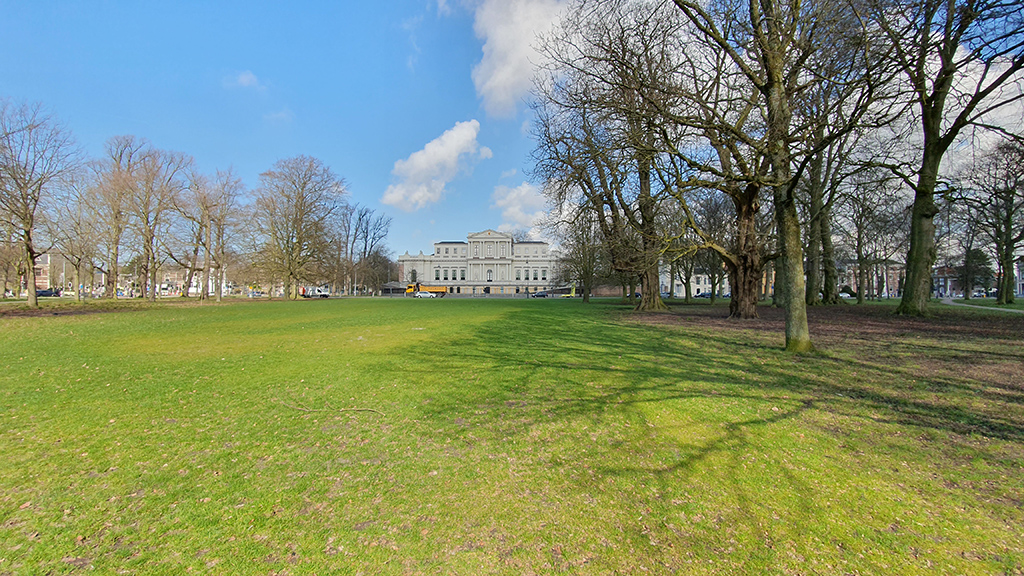
Medium focal:

Televik ("tele" here is of course conditional, only 2x):

As a conditional “standard”, we take a not new, but quite decent camera, the Canon EOS 7D with a lens of 18-135:
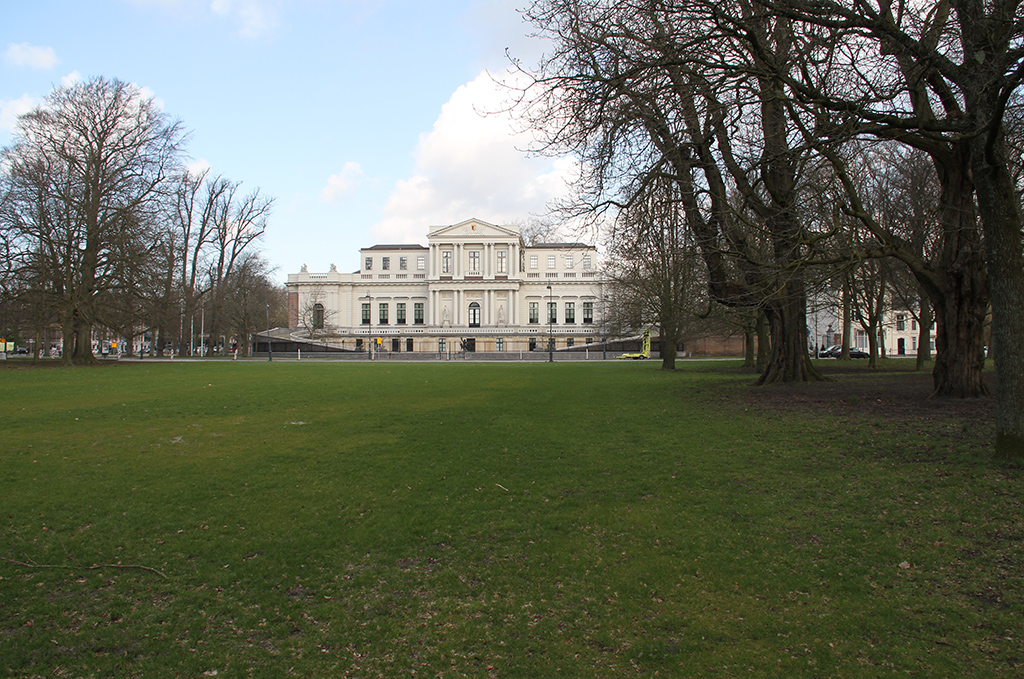
It is clear that the comparison is not quite correct (7D is more sharpened for other tasks - if shooting is needed in the studio, or sports shooting, or controlling the outside light, then DSLR is out of competition), but in this case we will be interested only in resolution and color reproduction.
Let's look at the crop in 100% resolution (in the pictures the left corner, center and right corner, respectively).
Shirik S10:

All the charms are visible around the edges - and the resolution and aberration drops. All widths, however, often have a rather mediocre image around the edges - there are certain physical difficulties in making wide-angle lenses.
But the main camera was pleasantly surprised - all more or less clearly:

Not “crystal clear” and not an L-fix of course, but considering that we are looking at a 4032-pks wide image, this is quite normal.
Televik:
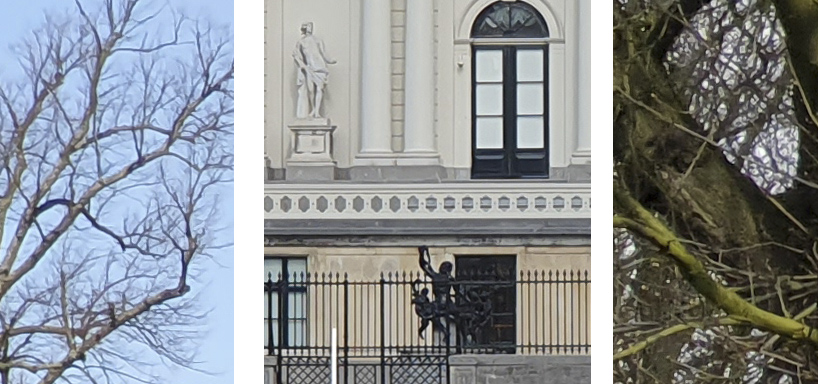
By the way, EOS 7D did not show any significant advantage in the microcontrast.
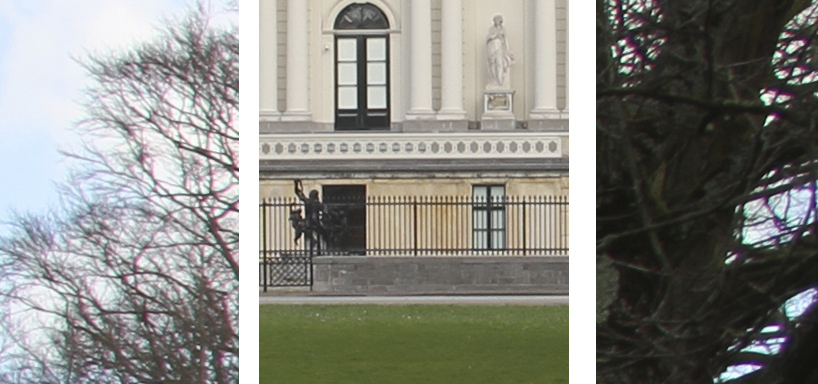
It is clear that in the corners of all budget lenses is imperfect, and the Bayer matrix, by its principle, does not convey details in one pixel, so small branches are a complex object for any camera.
But at the maximum zoom the smartphone, of course, has no chance against the 135mm. Shooting from the same point:

(but there is no such wide angle on this lens either)
Shirik, by the way, the S10 is quite a wide-angle, they can remove something like this:
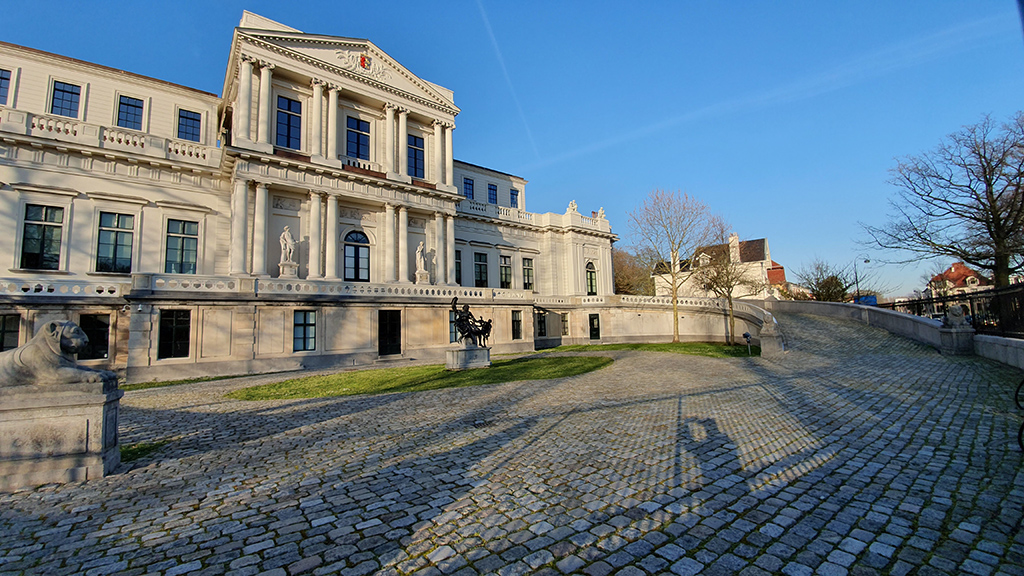
I will say right away that you should be able to shoot and choose a composition for a wide-angle lens so that it is artistic. I personally do not know how. But there is such an opportunity, which is already nice.
Color rendition
On S10, everything is quite good, and the picture looks approximately the same as it was at the time of shooting:
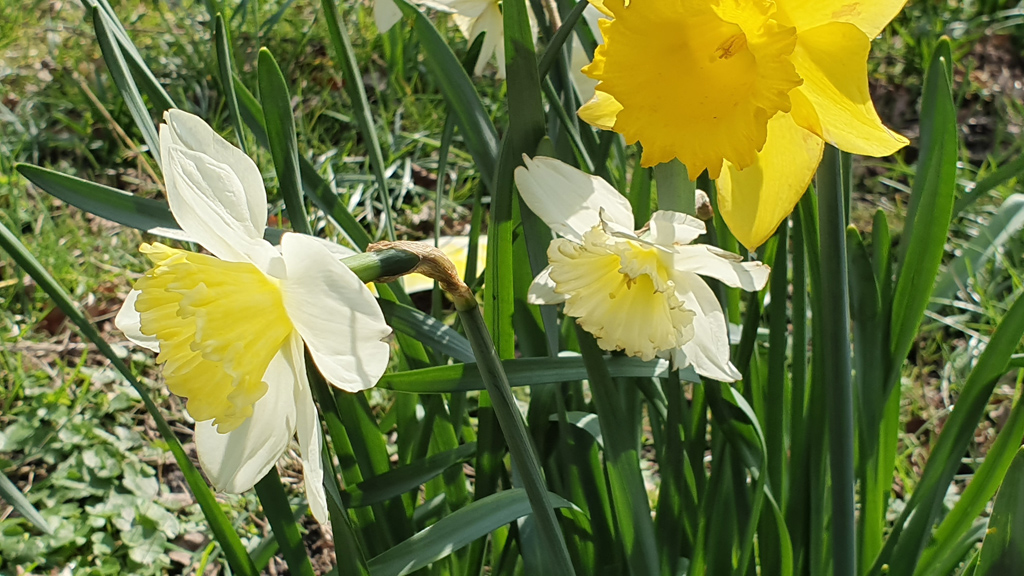
But EOS 7D allows you to get bokeh, inaccessible to small matrices:

Evening / night shooting
Finally, the most difficult genre for any camera is shooting with a lack of light. Of course, the large matrix here has a tremendous advantage in terms of size and lower pixel noise. On the other hand, the small size of the matrix makes it possible to easily make high-aperture optics - lenses wider than F2.0 for DSLR cost a lot of inhumane money, and on the smartphone F1.5 + OIS will end up with almost the same gain in luminosity than any budget -Kitovy F4.5 without stabilizer.
From personal experience, even on mirrors the night shooting from the hands is very difficult - the noises are very high. On S10, the situation is about the same - in principle, you can shoot c of hands, but even on the preview there is a noise in the sky:

1/10 F1.5 ISO1250
If you take a tripod (mini-tripods for smartphones can be found on sale) and manually set the ISO50, the frame is noticeably cleaner, but the shutter speed is of course longer:

2c, F1.5 ISO 50
In general, in terms of color reproduction, the frame is quite good, and quite corresponds to what was visible with the naked eye.
Judging by the articles appearing including on Habré, mobile photography is a very actively developing market segment. And the result is, in general, we can say that for non-professional amateur photography, top-end smartphones almost caught up with entry-level SLRs (especially if used with cheap and dark whale lenses).
What awaits us next? Promising can be called a number of areas.
Portrait shooting
Of course, physically a small matrix of the smartphone can not display a full bokeh. However, it is quite possible to display it programmatically, and there are 2 methods. The first is purely soft - modern algorithms are quite able to select a person against the background of everything else and blur the background. The second method is the use of two cameras (with one or different focal lengths), which makes it possible to build a “depth map” at the expense of parallax and, as a result, to make the blurring more accurate.
Once again it can be repeated that there will never be an ideal bokeh from a smartphone - it is physically not there, maybe only a software Blur to one degree or another. On the other hand, small artifacts that are visible only at 100% magnification, and even if you know what to look at, most users simply will not notice. Although of course flaws are sometimes noticeable:
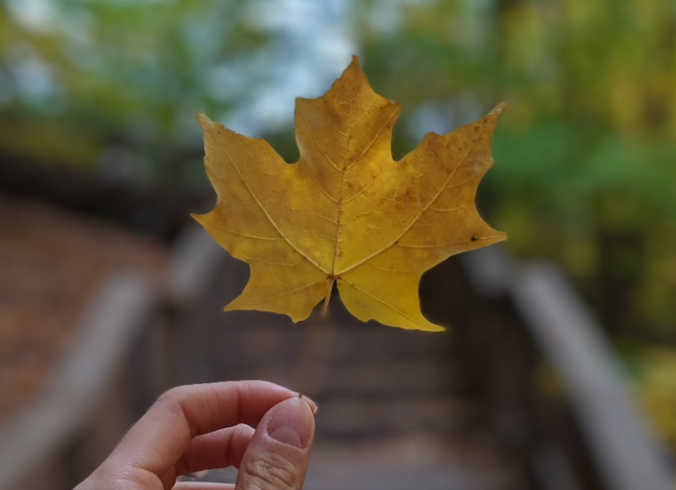
(source - youtube review )
By the way, since the blur is done programmatically, shooting in RAW gives such cameras a unique opportunity to choose the location and zone of sharpness after shooting . An example can be found in the reviews of Nokia PureView.
Dynamic range and HDR
The dynamic range of matrices of modern smartphones is in itself quite good. More promising is the use of a second lens - by taking two shots at the same time, you can get a picture with a much larger DD. Of course, the charge for this is the need for two identical lenses. Let's see what happens with Nokia with this approach.
Even without a second lens, high-speed shooting allows you to combine images into one, reducing noise. This is how night shot on Google Pixel works. The technology is certainly not new, astrophoto amateurs have been using it for many years, just the computational power allows it to be done almost automatically.
Shutter lag
Another frequent complaint about the "soap cases" - a long shutter release. The problem is solved in Google Pixel - the camera saves the images permanently to the ring buffer of the memory, and when you click on the "trigger" the frame is actually ready, you just have to get it out of the buffer. There is also a large space for post-processing, for example, you can automatically select the sharpest frame from several.
Of course, there are a number of shortcomings that are unlikely to be eliminated in smartphones.
Inconvenience of management. A modern slim smartphone fits comfortably in your pocket, but just as uncomfortable in your hand. If we talk about photography, then the lack of full-fledged manual control, fast mode switching, a strap for hanging on the neck, and finally - a professional camera is still more convenient for long-term shooting.
Optics limits. It is clear that a large zoom is not placed in a thin case, there are also design limitations on the size of the matrix. About portrait photography, too, was said.
Technology is changing. More recently, shooting from a smartphone was only good enough to retake the ad on the door of the entrance. Today we are already discussing shooting in RAW, optical stabilization and HDR. Yes, by the way, people with digital cameras are almost not visible on the street right now. What will happen next, we'll see ...
Of course, all of the above applies to amateur photography. Professional photography, of course, will remain - sports, reporting, studio photography and other genres, they will not go anywhere. And for those amateur photographers who still use the oldNokia 3310 smartphone, but would like to have a camera that is always with you - it probably already makes sense to think about upgrading.
Several video reviews of photo capabilities of modern smartphones under the spoiler.
Like probably almost all amateur photographers, I'm with some skepticism about taking pictures on mobile phones. Everyone knows about the small matrix, simple optics, and so on. On the other hand, it must be admitted that the possibilities of mobile photography are improving, the matrix becomes less noisy, optical stabilization appears in smartphones, and so on. And finally, when Samsung announced a new smartphone with three cameras (wide-angle, normal and tele), I still could not resist and decided that it was time to take.

Nokia 9 PureView - smartphones are no longer limited to three cameras
')
How it works, and what opportunities the modern smartphone gives the amateur photographer, details under the cut. Caution traffic.
Iron
For a start, let's see what is available to the user in terms of "hardware" (all further will relate to the Galaxy S10).
Main camera : 12Mpx, F1.5 / 2.4 switchable aperture, 77˚ viewing angle, optical stabilization (OIS), super-fast (as stated in the advertisement :) autofocus, pixel size 1.4μm.
Telephoto camera : 12Mpx, aperture F2.4, fast phase autofocus (PDAF), OIS, viewing angle 45˚, pixel size 1.0μm.
Wide-angle camera : 16MPx, aperture F2.2, viewing angle 123˚, pixel size 1.0μm.
(in the comments there was a question about EGF of lenses - they are not given in the specification)
Overall, quite good. Not ideal of course, but it is clear that a full-fledged diaphragm, for example, is difficult to shove into the thickness of a smartphone.
Now let's see what opportunities the software gives us.
Soft
The camera application built into the smartphone, surprisingly, has quite a few settings. Preset scenes like “Food”, “Cats”, “Dogs” (yes, there are 2 different modes , although I don’t know how they differ) are not so interesting, let's see the so-called “pro” mode:

Here you can configure the following parameters:
ISO - 50-800.
Shutter speed - 1/24000 - 10s, switching aperture F1.5 / 2.4.
White balance - auto or manual.
Focus - auto or manual (in manual mode, sharp areas are highlighted with a green frame)
Recording format: JPEG or JPEG + RAW.
Everything looks quite good, and quite at the level of advanced digital cameras. Unfortunately, there is a fly in the ointment - the pro-mode is available only for the “main” camera. Either this hardware limitation (maybe, only the “main” matrix supports ISO change), or the software is just unfinished, it's hard to say.
By the way, anyone can download the alternative Open Camera program from Google Play, which also provides quite a few settings:

Testing
So, let's proceed to the tests. For the first test, we will choose a typical “tourist” scenario - shooting of sights on a sunny day.
For those who want to see for themselves, full-size photos are available as an archive as a whole .
Wide-angle lens:

Medium focal:

Televik ("tele" here is of course conditional, only 2x):

As a conditional “standard”, we take a not new, but quite decent camera, the Canon EOS 7D with a lens of 18-135:

It is clear that the comparison is not quite correct (7D is more sharpened for other tasks - if shooting is needed in the studio, or sports shooting, or controlling the outside light, then DSLR is out of competition), but in this case we will be interested only in resolution and color reproduction.
Let's look at the crop in 100% resolution (in the pictures the left corner, center and right corner, respectively).
Shirik S10:

All the charms are visible around the edges - and the resolution and aberration drops. All widths, however, often have a rather mediocre image around the edges - there are certain physical difficulties in making wide-angle lenses.
But the main camera was pleasantly surprised - all more or less clearly:

Not “crystal clear” and not an L-fix of course, but considering that we are looking at a 4032-pks wide image, this is quite normal.
Televik:

By the way, EOS 7D did not show any significant advantage in the microcontrast.

It is clear that in the corners of all budget lenses is imperfect, and the Bayer matrix, by its principle, does not convey details in one pixel, so small branches are a complex object for any camera.
But at the maximum zoom the smartphone, of course, has no chance against the 135mm. Shooting from the same point:

(but there is no such wide angle on this lens either)
Shirik, by the way, the S10 is quite a wide-angle, they can remove something like this:

I will say right away that you should be able to shoot and choose a composition for a wide-angle lens so that it is artistic. I personally do not know how. But there is such an opportunity, which is already nice.
Color rendition
On S10, everything is quite good, and the picture looks approximately the same as it was at the time of shooting:

But EOS 7D allows you to get bokeh, inaccessible to small matrices:

Evening / night shooting
Finally, the most difficult genre for any camera is shooting with a lack of light. Of course, the large matrix here has a tremendous advantage in terms of size and lower pixel noise. On the other hand, the small size of the matrix makes it possible to easily make high-aperture optics - lenses wider than F2.0 for DSLR cost a lot of inhumane money, and on the smartphone F1.5 + OIS will end up with almost the same gain in luminosity than any budget -Kitovy F4.5 without stabilizer.
From personal experience, even on mirrors the night shooting from the hands is very difficult - the noises are very high. On S10, the situation is about the same - in principle, you can shoot c of hands, but even on the preview there is a noise in the sky:

1/10 F1.5 ISO1250
If you take a tripod (mini-tripods for smartphones can be found on sale) and manually set the ISO50, the frame is noticeably cleaner, but the shutter speed is of course longer:

2c, F1.5 ISO 50
In general, in terms of color reproduction, the frame is quite good, and quite corresponds to what was visible with the naked eye.
Perspectives
Judging by the articles appearing including on Habré, mobile photography is a very actively developing market segment. And the result is, in general, we can say that for non-professional amateur photography, top-end smartphones almost caught up with entry-level SLRs (especially if used with cheap and dark whale lenses).
What awaits us next? Promising can be called a number of areas.
Portrait shooting
Of course, physically a small matrix of the smartphone can not display a full bokeh. However, it is quite possible to display it programmatically, and there are 2 methods. The first is purely soft - modern algorithms are quite able to select a person against the background of everything else and blur the background. The second method is the use of two cameras (with one or different focal lengths), which makes it possible to build a “depth map” at the expense of parallax and, as a result, to make the blurring more accurate.
Once again it can be repeated that there will never be an ideal bokeh from a smartphone - it is physically not there, maybe only a software Blur to one degree or another. On the other hand, small artifacts that are visible only at 100% magnification, and even if you know what to look at, most users simply will not notice. Although of course flaws are sometimes noticeable:

(source - youtube review )
By the way, since the blur is done programmatically, shooting in RAW gives such cameras a unique opportunity to choose the location and zone of sharpness after shooting . An example can be found in the reviews of Nokia PureView.
Dynamic range and HDR
The dynamic range of matrices of modern smartphones is in itself quite good. More promising is the use of a second lens - by taking two shots at the same time, you can get a picture with a much larger DD. Of course, the charge for this is the need for two identical lenses. Let's see what happens with Nokia with this approach.
Even without a second lens, high-speed shooting allows you to combine images into one, reducing noise. This is how night shot on Google Pixel works. The technology is certainly not new, astrophoto amateurs have been using it for many years, just the computational power allows it to be done almost automatically.
Shutter lag
Another frequent complaint about the "soap cases" - a long shutter release. The problem is solved in Google Pixel - the camera saves the images permanently to the ring buffer of the memory, and when you click on the "trigger" the frame is actually ready, you just have to get it out of the buffer. There is also a large space for post-processing, for example, you can automatically select the sharpest frame from several.
disadvantages
Of course, there are a number of shortcomings that are unlikely to be eliminated in smartphones.
Inconvenience of management. A modern slim smartphone fits comfortably in your pocket, but just as uncomfortable in your hand. If we talk about photography, then the lack of full-fledged manual control, fast mode switching, a strap for hanging on the neck, and finally - a professional camera is still more convenient for long-term shooting.
Optics limits. It is clear that a large zoom is not placed in a thin case, there are also design limitations on the size of the matrix. About portrait photography, too, was said.
findings
Technology is changing. More recently, shooting from a smartphone was only good enough to retake the ad on the door of the entrance. Today we are already discussing shooting in RAW, optical stabilization and HDR. Yes, by the way, people with digital cameras are almost not visible on the street right now. What will happen next, we'll see ...
Of course, all of the above applies to amateur photography. Professional photography, of course, will remain - sports, reporting, studio photography and other genres, they will not go anywhere. And for those amateur photographers who still use the old
Several video reviews of photo capabilities of modern smartphones under the spoiler.
Spoiler
Source: https://habr.com/ru/post/444462/
All Articles